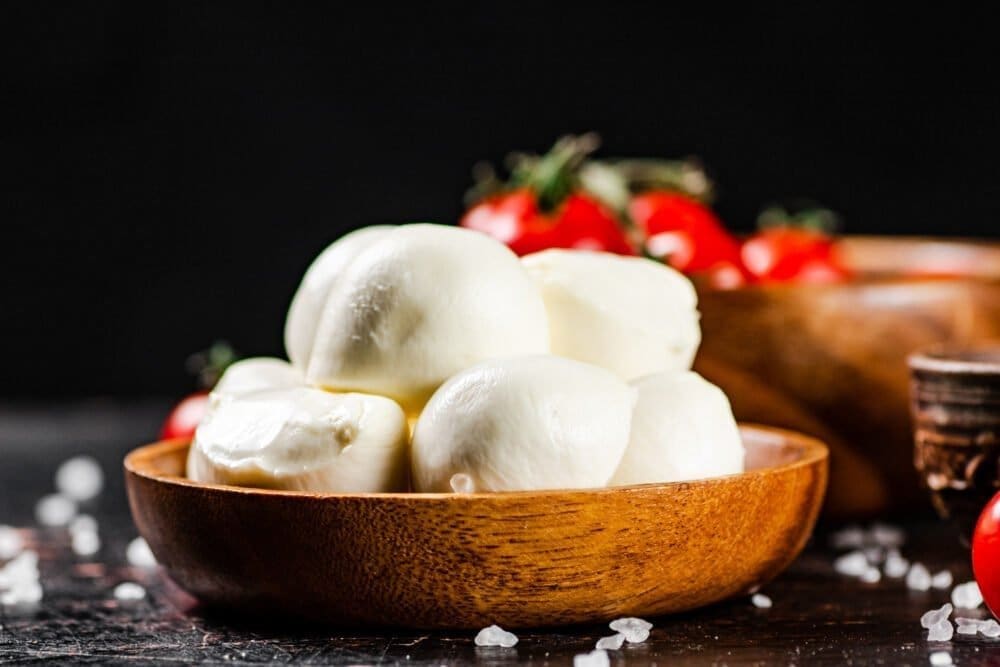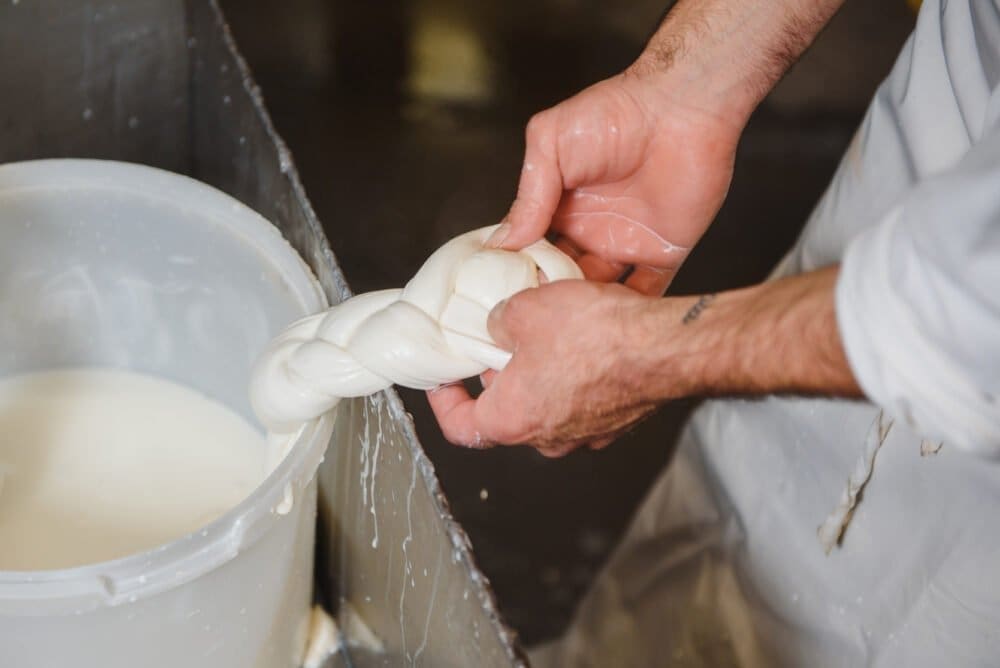Table of Contents Show
Ah, mozzarella! This cheese that makes food lovers drool and brightens up our dishes. Whether on a crispy pizza, in a colorful Caprese salad, or simply served with fresh bread, mozzarella brings that irresistible creaminess we all adore. In short, it’s the star ingredient that transforms an ordinary meal into an unforgettable feast. But beware! In the enchanting world of this Italian cheese lies a real puzzle: not all mozzarella is created equal.
Counterfeits abound on the market. Who hasn’t been duped by a tasteless, rubbery mozzarella? Between the cheaper yet disappointing impostors and the real artisanal gems, making the right choice can quickly become a daunting task. That’s where we come in! In this article, we’ll guide you on how to spot these fake cheeses before they make their way onto your plate. Stay with us to discover how to savor real mozzarella while avoiding the traps set by imposters!
What is real mozzarella?
Mozzarella is an iconic cheese of Italian cuisine, but not all mozzarella is made the same! Two of the most well-known types are mozzarella di bufala and mozzarella fiordilatte. The first comes from buffalo milk and is distinguished by its rich, creamy taste, often accompanied by a delicate, milky softness. On the other hand, mozzarella fiordilatte is made from cow’s milk, offering a slightly less creamy texture and a milder taste. Imagine a contest: on one side, the creamy princess who elegantly dances on bread; on the other, the charming girl with an engaging smile – both wonderful in their own way, but each with its unique character!
The origin of the cheese also matters. Real mozzarella di bufala must be produced in certain regions of Italy, like Campania or Lazio, to bear this prestigious name. The traditional techniques used in these areas ensure not only exceptional quality but also an authentic flavor you may not find elsewhere. If a product claims to be “mozzarella di bufala” but comes from a distant country or has dubious ingredients, it’s very likely an impostor.

Then, there’s the production process! Making true cheese requires care and skill: curdling the milk at the right temperature, followed by delicate kneading to achieve that perfect consistency. This step is crucial, as it allows the fibers to develop properly, giving our beloved mozzarella its characteristic stretchy texture. If you ever watch an artisanal demonstration where cheesemakers showcase their talents by stretching the hot cheese before your amazed eyes, prepare for a memorable experience – it’s almost magical!
In summary, distinguishing between mozzarella di bufala and fiordilatte is just the beginning; understanding the origin and production process will elevate your culinary experience. Whether you’re an enlightened enthusiast or a novice cook, investing in authentic mozzarella will instantly enhance your homemade dishes!
The telltale signs of low-quality mozzarella
When it comes to mozzarella, texture is one of the first indicators that can betray an impostor. Real mozzarella, whether di bufala or fiordilatte, has a texture that’s both soft and elastic. If you pull on your piece of cheese and it resists with a certain firmness before stretching like an elastic, bingo! You’re probably in the presence of authentic mozzarella. On the other hand, if the cheese feels grainy or crumbles between your fingers, prepare yourself to taste a pale imitation. Here’s a tip: try the “stretch test”! Take a small piece in your hands and pull gently; legitimate mozzarella should break down delicately into strands like a spider’s web.
In terms of taste, the difference is just as striking. Real mozzarella reveals delicate, creamy notes in the mouth, with a subtle hint of salt that enhances the flavors of your dishes. In contrast, a lower-quality product tends to have a more pronounced, artificial taste, sometimes with a rubbery aftertaste – it’s like comparing a ripe tomato coulis to a bland industrial version. When you bite into a real piece of mozzarella di bufala, for example, expect to explore rich, complex milky flavors that awaken your taste buds, transporting them to where they belong: atop your freshly baked Margherita pizza!
Another interesting element to observe is the possible presence of added aromas in more questionable cheeses. If your mozzarella has overly strong (and artificial) scents, run away! Natural aromas should be enough to seduce without needing added ones to mask their inauthenticity. Here, your palate becomes your best ally: be curious and ready to question what you taste!
Finally, once you know how to spot warning signs related to texture and taste, you’ll be better equipped to avoid culinary impostors that could ruin your dishes. Whether at home or in a fine restaurant, always remember: every bite counts in the flavorful world of our beloved mozzarella!
Reading the Label: don’t be fooled!
In a world where real mozzarella is often replaced by impostors, knowing how to read product labels is a crucial skill for any cheese lover. The importance of labels and certifications cannot be underestimated. Look for symbols that guarantee authentic production, such as the “Mozzarella di Bufala Campana DOP” label. This label indicates that the product was made in specific regions of Italy and according to traditional methods, thus guaranteeing superior quality.
But what does this actually mean for the consumer? First, when you scrutinize the packaging in your favorite supermarket, pay close attention to vague descriptions that simply say “mozzarella” without specifying the origin. Some producers use marketing tricks with similar words to fool the customer’s eye. Also, check the ingredients: if you see additives or artificial colors, be extra cautious! A good mozzarella should mainly consist of milk, salt, and possibly rennet – not a cocktail of indecipherable chemicals.
It’s also wise to pay attention to the product’s origin on the label. Being from Italy isn’t enough; it has to be the right region – Campania being famous for its mozzarella di bufala, for instance. Know that some artisanal cheesemakers offer their own local production honoring this tradition — these small artisans often deserve our support more than the large industrial brands that prioritize profit over authentic quality.
So, before filling your basket with this coveted creamy cheese, arm yourself with critical thinking toward labels and eliminate all doubt! With these tips in mind, you’ll not only avoid counterfeits but also navigate with ease in the delicious, flavor-rich world of true mozzarella.
Artisan Mozzarella: more than just taste
Artisan mozzarella stands out from its industrial counterpart. Artisan methods, based on traditional recipes, prioritize ingredient quality and manual techniques. For instance, while industrial mozzarella may contain additives like preservatives or stabilizers to extend its shelf life, artisan mozzarella relies solely on fresh, natural milk. A report by the Mediterranean Agronomic Institute of Montpellier reveals that nearly 75% of consumers prefer artisan mozzarella for its authentic taste.

Choosing artisan mozzarella isn’t just about taste. Indeed, the sensory experience is enhanced by respecting the natural milk cycle and avoiding artificial interventions. According to gastronomy experts, this production method allows the cheese to reveal its subtle flavors, providing an unparalleled culinary pleasure to cheese lovers. Mozzarella di bufala, for example, offers a unique creamy taste not found in mass-produced varieties.
From a nutritional perspective, artisan mozzarella has notable advantages. It generally contains fewer chemical additives and better preserves its nutrients thanks to quick processing after milking. A study by the National Center for Specialized Food Studies showed that artisan mozzarella could be up to 20% richer in protein and calcium than some industrial versions – a valuable asset for those who want to maintain a balanced diet while enjoying their favorite dishes. Furthermore, supporting responsible production encourages producers to adopt sustainable practices that benefit both consumers and the environment.



